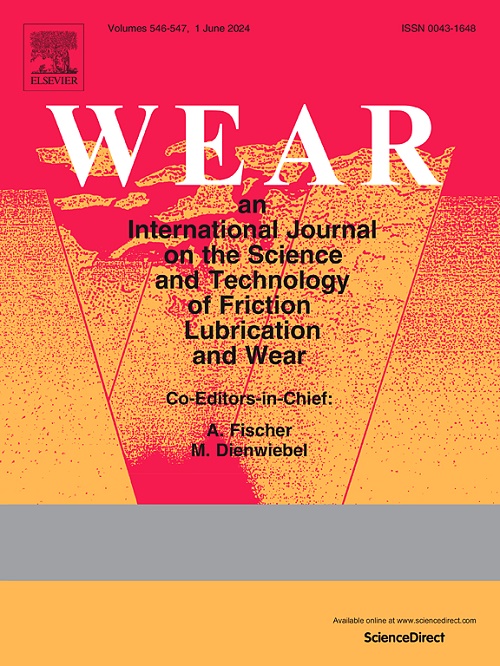Improving tribological performance of 3D-printed PEEK and CFR-PEEK composites by combining optimized deposition strategies and post-processing conditions
IF 5.3
1区 工程技术
Q1 ENGINEERING, MECHANICAL
引用次数: 0
Abstract
Controlling the tribological performance of fused filament fabrication (FFF) components remains a challenge, which depends on the understanding of their wear mechanisms. In this study, the effects of deposition strategies (Top, Front, and Side, corresponding to sliding surfaces perpendicular to the building, transverse, and scanning directions, respectively) and annealing temperatures (200 °C, 250 °C, and 300 °C) on the anisotropic tribological performance of FFF-printed polyether ether ketone (PEEK) and short carbon fiber-reinforced PEEK (CFR-PEEK) were investigated. We used a 316 L stainless steel ball as the counterpart for reciprocating sliding wear tests under water-lubricated conditions, detailing how the shift in the wear mechanism is attributed to the combined effect of the interfacial weld strength of the deposited layers, the fiber-matrix bonding strength, and the matrix crystallinity. The results show that the specific combination of deposition strategy and annealing temperature can effectively improve the wear performance of FFF-PEEK composites. For CFR-PEEK, the wear performance of Top specimens was best at the annealing temperature of 200 °C, Front specimens at 300 °C, and Side specimens were unsatisfactory at all annealing temperatures. Furthermore, fiber orientation is the predominant factor in determining the anisotropic tribological performance of CFR-PEEK, but the effect of the deposited layer orientation on the anisotropy should not be neglected. The findings offer critical insights for optimizing the design and fabrication of FFF-PEEK components for tribological applications.
结合优化的沉积策略和后处理条件,提高3d打印PEEK和CFR-PEEK复合材料的摩擦学性能
控制熔丝制造(FFF)部件的摩擦学性能仍然是一个挑战,这取决于对其磨损机制的理解。在本研究中,研究了沉积策略(分别对应于垂直于建筑、横向和扫描方向的滑动面Top、Front和Side)和退火温度(200°C、250°C和300°C)对fff打印聚醚醚酮(PEEK)和短碳纤维增强PEEK (CFR-PEEK)各向异性摩擦学性能的影响。我们使用316l不锈钢球作为对应物,在水润滑条件下进行往复滑动磨损试验,详细说明了磨损机制的变化是如何归因于沉积层的界面焊接强度、纤维-基体结合强度和基体结晶度的综合影响。结果表明,沉积策略和退火温度的特定组合可以有效提高FFF-PEEK复合材料的磨损性能。对于CFR-PEEK, Top试样在200℃退火时磨损性能最好,Front试样在300℃退火时磨损性能最好,而Side试样在所有退火温度下的磨损性能都不理想。此外,纤维取向是决定CFR-PEEK各向异性摩擦学性能的主要因素,但沉积层取向对各向异性的影响不容忽视。研究结果为优化用于摩擦学应用的FFF-PEEK组件的设计和制造提供了重要见解。
本文章由计算机程序翻译,如有差异,请以英文原文为准。
求助全文
约1分钟内获得全文
求助全文
来源期刊

Wear
工程技术-材料科学:综合
CiteScore
8.80
自引率
8.00%
发文量
280
审稿时长
47 days
期刊介绍:
Wear journal is dedicated to the advancement of basic and applied knowledge concerning the nature of wear of materials. Broadly, topics of interest range from development of fundamental understanding of the mechanisms of wear to innovative solutions to practical engineering problems. Authors of experimental studies are expected to comment on the repeatability of the data, and whenever possible, conduct multiple measurements under similar testing conditions. Further, Wear embraces the highest standards of professional ethics, and the detection of matching content, either in written or graphical form, from other publications by the current authors or by others, may result in rejection.
 求助内容:
求助内容: 应助结果提醒方式:
应助结果提醒方式:


